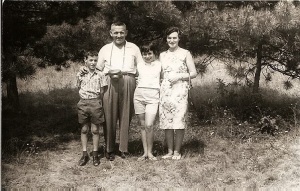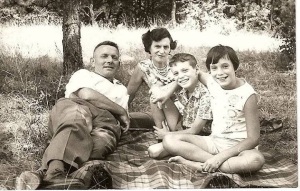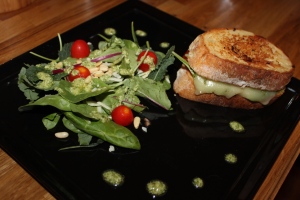A late start in the Canadian Food Experience Project meant I didn’t intend to go backwards and complete previous months’ challenges. This was due to two factors: first, a lack of spare time at present and second, a difficulty in thinking of authentic “Canadian” food memories. Then, I read the blog entry of a friend of mine who gave me an entirely different perspective on this challenge. The creative juices started flowing and lo and behold, so did the memories.
I’ve mentioned a few times that I did not grow up in a traditionally Canadian family. Though my paternal grandmother was actually born in Czechoslovakia and my maternal grandfather in Transylvania (Romania), they eventually ended up in Hungary. I consider my whole family Hungarian since Hungary is where they spent most of their lives preceding World War II, Hungarian is the only language aside from English spoken in the family, and Hungarian food formed the foundation of my childhood nourishment. In our own home, my mother was (and still is) a very skilled cook, and experimented with delicious foods from around the globe. Thus, when I read that the June challenge for the CFEP was to write about an authentic Canadian food memory, I turned up nothing at first. Then, as I said, I found new perspective in the idea that as Canadians, we are very much a collection of interesting, multicultural and multiethnic people who found themselves in this wonderful country of Canada. Our identity is largely founded in our weaving together so many heritages and experiences into a beautiful tapestry. My Hungarian heritage and my family traditions have helped to form who I am, so this is undeniably part of my Canadian identity. Moreover, the childhood memories I have of food are inspired by a vast array of culinary treats, techniques and attitudes that were themselves founded in European ideals. These shaped me while I matured, surrounded by the landscape, people and collective culture of Canada.
My early food memoirs are poignant, and it is difficult to chronicle one particular event or circumstance. Accordingly, I will share two collections of experiences that induce a great, emotional response in me.
My paternal grandmother was not the warmest woman; she did not show much physical affection and she could be critical and even harsh at times. This was unquestionably as a result of the thorny life she had experienced before coming to Canada. Where she was extremely gifted was in the art of cooking, and she showed her love for her family through her food. In return, she expected her family to eat multiple helpings of her heavy, rich Hungarian meals, in fine stereotypical form. Every Saturday afternoon, the family would gather around her dining table to enjoy a mid-afternoon three-course meal. There were ten of us in total before my grandfather died, and then more once my cousins starting bringing their girlfriends home to Grandma’s house for approval. If they did not eat enough, they were not fit for the family.
This table was the heart of enthusiastic dining, conversation and debate. I loved being surrounded by my family, though oblivious at that time to the conflictual undercurrents I was yet too young to recognize. My grandmother’s meals were simply mouthwatering, always authentic, and eternally consistent. As well, her dishes were ultimately inimitable because she never used a single recipe. Though I have a few Hungarian dishes in my own repertoire that are pretty delicious, they will never compare to hers, nor will any dish eaten in a restaurant. I even have a few scribbled recipes in my collection that I attempted to record while watching her create in the kitchen. These include ridiculous directions like: “pile a bunch of flour on the countertop and crack three eggs into the center…..” with no measurements to speak of. Somehow, that “recipe” for Beigli (a walnut or poppy seed filled, rolled cake) has turned out, thanks only to my years of observation and tasting.
My grandmother’s appreciation for fresh, local ingredients was also immense, as I reflect back now. Though she did not have space for her own garden, my mother would take her every Friday to the enormous local farmer’s market, where she would purchase all her produce for the weekend gathering. She made friends with many of the farmers, who knew her by name. When she got older and weaker, some of them would pull up a chair and she would sit down and chat for a few minutes while my mom ran some of her own errands. Contrary to the unaffectionate demeanor she usually bore, she was actually very sociable with strangers and developed some very strong and lasting friendships.
My sister and I took turns having separate sleepovers at our grandparents’ houses every Saturday night until we were in our mid-teens and started wanting to see our friends instead. I loved that time with all of my grandparents, and during those evenings spent alone with them I was spoiled with attention and food. On no other occasions in my childhood was I so free to eat so many sweets, to snack as often as I liked, to be waited on hand and foot, and even to eat butter with a spoon (no, not peanut butter, creamery butter).
If I really concentrate, I can still taste some of my Grandma’s food, years after her death. She was the true matriarch of the family, and after she moved into a long term care home, the family Saturday dinners ceased. The foundation of my grandmother’s love and the legacy she left behind was almost exclusively centered on food. And even though I initially developed some less healthy eating habits via poor examples of nutrition and self-control, I also recognize some of her positive traits in myself. Though my fundamental personality and desire to openly express love make me very dissimilar to her, I did acquire her passion for making others happy through food. I do in many respects equate happiness and loving relationships with gathering together to enjoy a meal.
This second collection of memories explains my love of fresh, natural ingredients and in particular, local or home-grown vegetables and fruit. My maternal grandfather’s ancestry was founded on food; his parents owned and ran a food production and canning business out of an outbuilding on their property in Hungary. They made dill pickles, vegetable marrow and other prized delicacies in large quantities, selling to local families and commercial businesses alike. He was actually a baker by trade, and so was put to work in this capacity while serving in the Navy. He hated the war so much that he never baked again, so sadly we never saw his skill in action. My Granny was the primary cook in the household despite her detestation of cooking. I’m convinced that the powerful love she had for those she was cooking for pushed her to persevere and learn to prepare tasty meals for us all.
My Grandpa had a passion for gardening. His colourful, fragrant rose bushes were the most beautiful I’ve seen to this day. They lined their driveway and passersby would often stop to admire them. He had a massive back garden, mostly devoted to an impressive collection of food plants. He grew raspberries, red currants and green wine grapes; cherries, pears, apples and plums; carrots, parsnips, potatoes and horseradish; lettuce, scallions and tomatoes; on the list goes. He was so incredibly proud of his annual harvest, and rightly so. His beautiful, colourful garden was organic before organic ever became a buzz-word. Grandpa’s passion was contagious, and at the age of 3 or 4, I was already fascinated. Every Sunday, we would spend the day with my Granny and Grandpa and eat our Sunday dinner there. Grandpa would take my hand and walk me through his vegetable plot, teaching me all about each plant. And every week, I would excitedly ask if the vegetables were ready to pick and eat. For weeks, he would explain to me that they were not yet ready, and that perhaps the following week I could eat some. The next week would come, and I’d be disappointed to hear that the veggies were still not ready to pick. My mother figures this was his way of ensuring I would want to come back, not that there should ever have been any doubt as I was extremely close to my maternal grandparents. Occasionally, I would mischievously grab a tomato and injure a branch, or go for a bunch of carrots. He would scold me and instruct me again on garden etiquette and how to gently remove fruit from the vine. Finally, after much patience, I would get to munch on the fresh fruit and vegetables at each plant’s harvest time. Back then, a whole, fresh scallion dipped in salt was a perfect snack to me, and I can still remember sitting with my little dipping bowl and resulting onion breath. I therefore grew up knowing the amazing taste of produce straight from the source, and the value of such magnificent products of hard work and care. Those gorgeous vegetables would then get incorporated into our many Hungarian family meals, and the flavour of those dishes was heightened by such incomparable freshness.
We have the immense benefit in Canada of being able to safely and freely grow so many varieties of food plants in our backyards, and my hands-on exposure to this at a young age, while bonding with my Grandpa, was an authentic and infinitely memorable Canadian experience.
So many memories come flooding back as I write and most do not belong here. Nevertheless, my life has been touched in many ways by the love of my grandparents, in many cases shown to me through food. I am eternally grateful for all that they taught me, including the way that meals inspired by great love touch the heart and soul, as well as nourish the body. Indeed, through their many examples, I learned the invaluable ethic of hard work, and the way in which our effort is evident in the products of our endeavors, be they edible or not.
The following photos are of my Grandpa, Granny, Mom and Uncle Gabe. I could not get my hands on an old photo of my paternal grandmother in time.


~~~~~~~~~~~~~~~~~~~~~~~~~~
The Canadian Food Experience Project is Valerie Lugonja’s call to Canadian Foodies and Bloggers alike to unite on the 7th day of each month and creatively discover and share Canada’s unique culinary voice. You can read more about this exciting project here.



